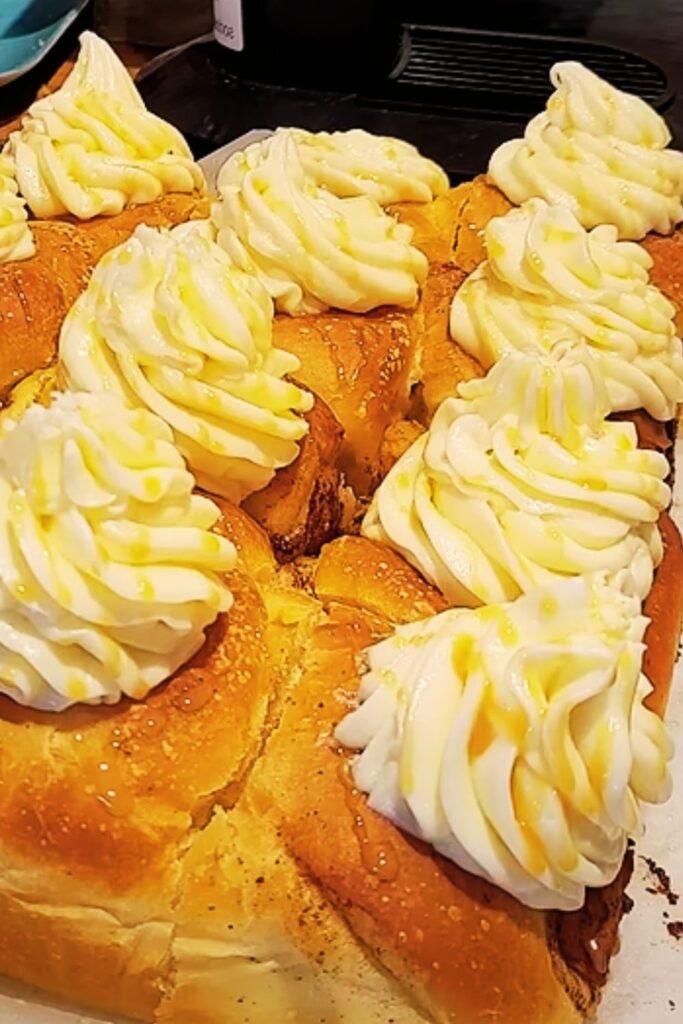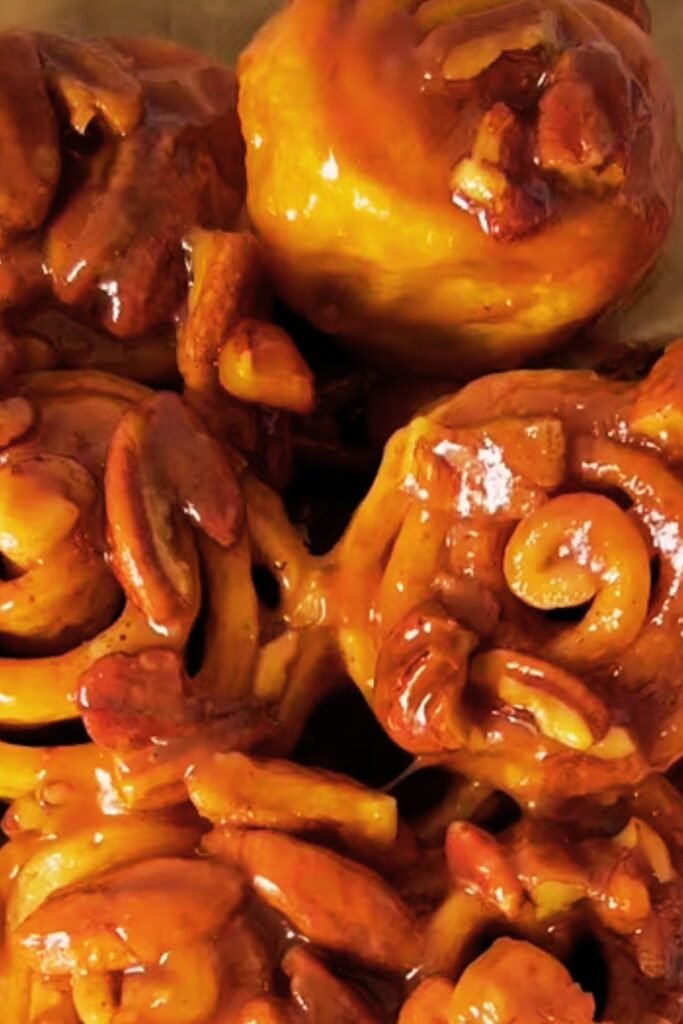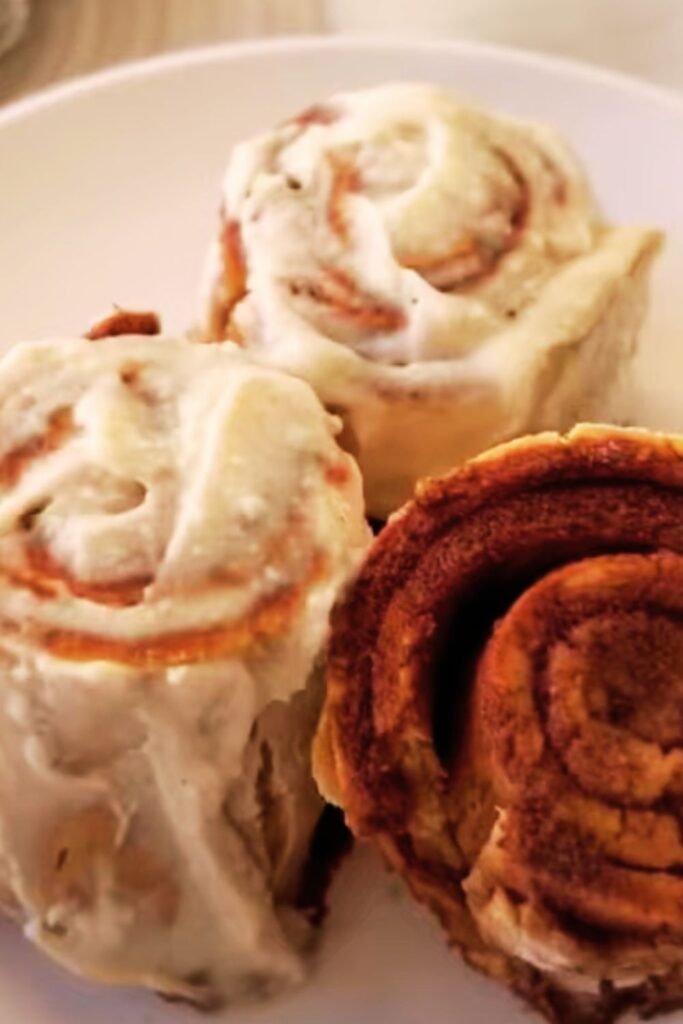There’s something magical about the smell of cinnamon rolls baking in the oven on a weekend morning. I’ve been perfecting my cinnamon roll recipe for years, and I can confidently say that these salted caramel cinnamon rolls with caramel cream cheese frosting are absolutely divine. The combination of buttery dough, warm cinnamon, rich caramel, and that perfect hint of sea salt creates a symphony of flavors that will have your family begging for more.
I first discovered this incredible flavor combination during a trip to a small bakery in Vermont. The baker shared her secret with me – it’s all about layering the caramel flavors throughout the process. From the filling to the frosting, every bite delivers that perfect balance of sweet and salty that makes these rolls absolutely irresistible.
Understanding the Perfect Cinnamon Roll
Before diving into this specific recipe, let me share what makes a cinnamon roll truly exceptional. After countless batches and experiments in my kitchen, I’ve learned that the perfect cinnamon roll requires attention to several key elements.
Dough Texture: The foundation of any great cinnamon roll is the dough. It should be soft, pillowy, and slightly enriched with butter and eggs. The dough needs to be elastic enough to roll without tearing, yet tender enough to create those fluffy layers we all love.
Filling Distribution: Many home bakers struggle with uneven filling distribution. The key is achieving the right balance of butter, sugar, and spices that won’t leak out during baking but will create distinct flavorful swirls throughout each roll.
Rise Timing: Proper fermentation is crucial. Under-proofed rolls will be dense and heavy, while over-proofed rolls can collapse and lose their beautiful spiral shape.
Baking Temperature: The perfect baking temperature ensures the rolls cook through without becoming dry on the outside or gummy in the center.
Ingredient Breakdown and Quality Matters
The success of these salted caramel cinnamon rolls relies heavily on using quality ingredients. I’ve experimented with various brands and types over the years, and I can tell you that the differences are noticeable in the final product.
| Ingredient Category | Premium Choice | Budget Alternative | Impact on Final Product |
|---|---|---|---|
| Flour | King Arthur Bread Flour | All-Purpose Flour | Bread flour creates better texture and rise |
| Butter | European-style unsalted | Regular unsalted butter | Higher fat content improves flavor and texture |
| Caramel | Homemade or Ghirardelli | Store-brand caramel sauce | Premium caramel has richer, more complex flavor |
| Sea Salt | Flaky sea salt (Maldon) | Table salt | Flaky salt provides better texture and flavor bursts |
| Vanilla | Pure vanilla extract | Imitation vanilla | Real vanilla adds depth and warmth |
| Cream Cheese | Philadelphia full-fat | Generic brand | Premium cream cheese creates smoother frosting |
For the flour, I strongly recommend using bread flour if you have it available. The higher protein content creates a more structured dough that can support all the delicious fillings without becoming soggy. However, if you only have all-purpose flour, the recipe will still work beautifully – just expect a slightly more tender crumb.
The Art of Homemade Caramel
While you can certainly use store-bought caramel sauce, making your own elevates these rolls to bakery-level quality. I make my caramel sauce a day ahead, which also helps with timing when you’re preparing the rolls.
Homemade Caramel Sauce Recipe:
- 1 cup granulated sugar
- 6 tablespoons unsalted butter
- 1/2 cup heavy cream
- 1 teaspoon vanilla extract
- 1/2 teaspoon sea salt
The process requires patience and attention. I heat the sugar in a heavy-bottomed saucepan over medium heat, stirring constantly until it melts and turns a beautiful amber color. The key is watching for that perfect moment when the sugar transforms from golden to deep amber – that’s when you know you’ve achieved the ideal caramel flavor depth.

Complete Recipe: Salted Caramel Cinnamon Rolls
For the Dough:
- 4 cups bread flour (or all-purpose flour)
- 1/4 cup granulated sugar
- 1 packet (2 1/4 teaspoons) active dry yeast
- 1 teaspoon salt
- 3/4 cup whole milk, warmed
- 1/4 cup unsalted butter, melted
- 1 large egg, room temperature
For the Caramel Cinnamon Filling:
- 1/2 cup unsalted butter, softened
- 3/4 cup brown sugar, packed
- 2 tablespoons ground cinnamon
- 1/2 cup homemade caramel sauce
- 1/2 teaspoon sea salt
For the Caramel Cream Cheese Frosting:
- 8 oz cream cheese, softened
- 1/4 cup unsalted butter, softened
- 2 cups powdered sugar
- 1/3 cup caramel sauce
- 1 teaspoon vanilla extract
- Pinch of sea salt
Step-by-Step Instructions:
Preparing the Dough (Day 1 or Morning): I start by combining the flour, sugar, yeast, and salt in my stand mixer bowl. In a separate measuring cup, I warm the milk to about 110°F – it should feel comfortably warm on your wrist, not hot. I whisk together the warm milk, melted butter, and egg, then pour this mixture over the dry ingredients.
Using the dough hook attachment, I mix on low speed until the ingredients come together, then increase to medium speed and knead for 8-10 minutes. The dough should be smooth, elastic, and slightly tacky but not sticky. If it’s too wet, I add flour one tablespoon at a time.
I place the dough in a greased bowl, cover it with a damp towel, and let it rise in a warm place for about 1 hour, or until doubled in size. During colder months, I create a warm environment by placing the bowl on top of my refrigerator or in an oven with just the light on.
Creating the Filling: While the dough rises, I prepare the filling by mixing the softened butter, brown sugar, and cinnamon until well combined. The mixture should be spreadable but not too thin. I set aside the caramel sauce and sea salt to add during assembly.
Assembly Process: Once the dough has doubled, I punch it down gently and turn it out onto a lightly floured surface. Using a rolling pin, I roll it into a 16×12 inch rectangle. The key is maintaining even thickness throughout – I use a ruler to check my dimensions.
I spread the cinnamon-sugar-butter mixture evenly across the dough, leaving about a 1/2 inch border on all sides. Then comes the magic moment – I drizzle the caramel sauce over the filling and sprinkle with sea salt.

Starting from the long side, I carefully roll the dough into a tight log, pinching the seam to seal. Using a sharp knife or unflavored dental floss, I cut the log into 12 equal pieces. I’ve found that dental floss creates cleaner cuts without squishing the rolls.
Second Rise and Baking: I arrange the cut rolls in a greased 9×13 inch baking dish, cover with a towel, and let them rise for another 30-45 minutes until puffy and touching each other.
I preheat my oven to 350°F and bake the rolls for 25-30 minutes, until golden brown on top. The internal temperature should reach 190°F when checked with a digital thermometer.
Mastering the Caramel Cream Cheese Frosting
The frosting is what transforms these good cinnamon rolls into extraordinary ones. I make sure all my ingredients are at room temperature before beginning – this ensures a smooth, lump-free frosting.
I beat the cream cheese and butter together until light and fluffy, about 3-4 minutes with an electric mixer. Gradually, I add the powdered sugar, beating well after each addition. Finally, I incorporate the caramel sauce, vanilla, and a pinch of sea salt.
The consistency should be creamy and spreadable. If it’s too thick, I add a tablespoon of milk; if too thin, I add more powdered sugar, 1/4 cup at a time.
Timing and Make-Ahead Strategies
One of the questions I get most often is about timing these rolls for special occasions or weekend brunches. I’ve developed several strategies that work beautifully:
| Timing Strategy | Process | Advantages | Considerations |
|---|---|---|---|
| Same Day | Make and bake in one day | Fresh, warm rolls | Requires 4-5 hours total |
| Overnight Method | Prepare through first rise, refrigerate | Fresh baked morning rolls | Need to plan ahead |
| Freeze After Shaping | Shape rolls, freeze, bake later | Can make weeks ahead | Requires extra rising time |
| Freeze After Baking | Bake completely, freeze, reheat | Ready-to-serve convenience | Slight texture difference |
My favorite method for weekend brunches is the overnight strategy. I prepare the dough and complete the first rise in the evening, then shape the rolls and place them in the refrigerated baking dish. In the morning, I let them come to room temperature and complete their second rise while I prepare coffee and set the table.
Troubleshooting Common Issues
Even experienced bakers encounter challenges with cinnamon rolls. Here are the most common problems I’ve encountered and how to solve them:
Dense, Heavy Rolls: This usually indicates under-proofed dough or too much flour. Make sure your yeast is fresh and active, and give the dough adequate rising time. The dough should feel soft and slightly tacky, not dry or stiff.
Filling Leaking Out: If your caramel filling leaks during baking, it might be too thin or the dough wasn’t sealed properly. Next time, use less liquid caramel in the filling and save extra for drizzling after baking.
Uneven Baking: If some rolls are darker than others, your oven might have hot spots. Rotate the pan halfway through baking, and consider using an oven thermometer to verify temperature accuracy.
Dry Rolls: Overbaking is the usual culprit. Cinnamon rolls continue cooking slightly after removal from the oven, so it’s better to err on the side of slightly underdone than overdone.

Serving Suggestions and Variations
These salted caramel cinnamon rolls are incredible on their own, but I love serving them as part of a special brunch spread. They pair beautifully with fresh fruit, particularly sliced strawberries or mixed berries that provide a bright contrast to the rich caramel flavors.
For coffee lovers, I recommend serving these with a robust medium roast coffee or a caramel macchiato that complements the caramel notes in the rolls. Hot chocolate is another wonderful pairing, especially during colder months.
Delicious Variations I’ve Tried:
- Apple Caramel: Add thin apple slices to the filling for extra texture and flavor
- Pecan Praline: Incorporate chopped toasted pecans into both the filling and frosting
- Chocolate Drizzle: Add a chocolate ganache drizzle over the caramel frosting
- Espresso Enhanced: Add a tablespoon of instant espresso to the frosting for mocha notes
- Seasonal Spices: Include a pinch of cardamom or nutmeg in the cinnamon filling
Storage and Reheating Tips
Proper storage ensures these rolls maintain their delicious texture and flavor. I store leftover rolls (if there are any!) covered at room temperature for up to 2 days. For longer storage, I wrap individual rolls in plastic wrap and freeze for up to 3 months.
When reheating, I prefer using the oven rather than the microwave. I wrap the rolls in foil and warm them at 300°F for about 10 minutes. This method helps restore their soft, fluffy texture without drying them out.
For individual servings, I sometimes warm a roll in the microwave for 15-20 seconds, then add a fresh dollop of frosting on top.
Nutritional Considerations and Modifications
While these rolls are definitely an indulgent treat, I understand that some people have dietary restrictions or preferences. I’ve experimented with various modifications over the years:
Reduced Sugar Version: You can reduce the sugar in both the filling and frosting by about 25% without significantly impacting the flavor or texture.
Whole Wheat Option: Substituting up to half the bread flour with whole wheat pastry flour adds fiber and nutrition while maintaining good texture.
Dairy-Free Adaptations: I’ve successfully made these using plant-based milk and vegan butter alternatives, though the flavor profile changes slightly.
The Science Behind Perfect Cinnamon Rolls
Understanding the science behind baking helps create consistently excellent results. The yeast in the dough feeds on sugars, producing carbon dioxide that creates the light, airy texture. The gluten development from kneading provides structure to trap these gases.
The caramelization that occurs during baking creates complex flavors and that beautiful golden-brown color. The Maillard reaction between proteins and sugars contributes to the deep, rich flavors that make these rolls so irresistible.
Temperature control is crucial throughout the process. Too-hot milk can kill the yeast, while too-cool rising temperatures slow fermentation. The oven temperature needs to be hot enough to set the structure quickly while allowing the interior to cook through.
Questions and Answers
Q: Can I make these cinnamon rolls without a stand mixer? I absolutely understand not everyone has a stand mixer! You can definitely make these by hand. Mix the ingredients in a large bowl until they come together, then turn out onto a floured surface and knead by hand for about 12-15 minutes. The dough is ready when it’s smooth, elastic, and springs back when gently poked.
Q: How do I know if my yeast is still active? Great question! I always test my yeast before using it, especially if it’s been sitting in my pantry for a while. Dissolve the yeast in warm water (about 110°F) with a pinch of sugar. If it bubbles and foams within 5-10 minutes, it’s active and ready to use. If nothing happens, the yeast is dead and needs to be replaced.
Q: Can I use instant yeast instead of active dry yeast? Yes, you can substitute instant yeast for active dry yeast in equal amounts. The main difference is that instant yeast can be mixed directly with the dry ingredients without proofing first. This can actually save you some time in the preparation process.
Q: Why did my caramel sauce crystallize? Crystallization happens when sugar crystals form in your caramel. This usually occurs if you stir the sugar while it’s melting or if there are any impurities in the pan. To prevent this, avoid stirring once the sugar starts melting, and make sure your pan is completely clean before starting.
Q: How can I make the rolls extra gooey? For extra gooey rolls, I reserve some of the caramel sauce and pour it over the shaped rolls just before the second rise. You can also brush the tops with melted butter halfway through baking. Just be prepared for some delicious messiness!
Q: Can I prep these the night before for a morning bake? This is one of my favorite techniques for weekend brunches! After shaping the rolls, cover them tightly and refrigerate overnight. In the morning, let them come to room temperature (about 30-45 minutes) and complete their final rise before baking. They might need an extra 10-15 minutes for the second rise.
Q: What’s the best way to cut the roll log without squishing it? I’ve found that unflavored dental floss works better than a knife for cutting clean slices. Slide the floss under the log, cross the ends over the top, and pull to slice through. If you must use a knife, make sure it’s very sharp and use a gentle sawing motion rather than pressing down.
Q: How do I prevent the filling from leaking out during baking? The key is not overloading with liquid ingredients and sealing the edge properly. When rolling up the dough, pinch the seam firmly to seal. If your caramel sauce is very thin, let it cool and thicken slightly before using, or use less of it in the filling and save extra for drizzling after baking.
Q: Can I freeze the baked rolls? Absolutely! I often make a double batch and freeze half for later. Let the baked rolls cool completely, then wrap individually in plastic wrap and store in freezer bags for up to 3 months. To reheat, thaw at room temperature and warm in a 300°F oven for about 10 minutes.
Q: My frosting turned out too thin – how can I fix it? If your frosting is too thin, gradually add more powdered sugar, about 1/4 cup at a time, beating well after each addition. Make sure your cream cheese and butter were properly softened but not melted before starting – this is usually the culprit behind thin frosting.
These salted caramel cinnamon rolls have become a beloved tradition in my home, and I hope they bring the same joy to yours. The combination of techniques I’ve shared here will help you create bakery-quality rolls that are sure to impress family and friends. Remember, baking is as much about love and patience as it is about following recipes – enjoy the process, and don’t be afraid to make them your own with personal touches and variations.